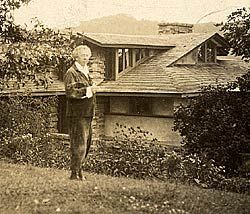Attention
Dark Day: Slaughter at Wright's Estate
105 years ago, a massacre destroyed what Frank Lloyd Wright had built.
Posted August 15, 2014

Frank Lloyd Wright aspired to be a successful, innovative architect. When he was 23, he married Catherine Lee Tobin. Soon, he built his first house, in Oak Park, and started a family. As Wright set up a business, his vision for the design and function of buildings attracted attention and he received prestigious commissions.
His life seemed to be going in just the right direction, until he met Martha “Mamah” Borthwick Cheney. In 1909, Wright and Mamah, now lovers, went on an extended trip to Europe. Catherine refused to give him a divorce, but Mamah had already left her husband. The affair became a scandal in their social circles.
Two years later, Wright and Mamah returned to the States. Unwelcome among the Chicago elite, Wright began construction near Spring Green, Wisconsin, of a grand house that he would name Taliesin. Mamah moved in with her two children.
Life seemed good in this quiet, secluded place until August 1914.
Based on a friend’s recommendation, Wright had hired a couple from Barbados, Julian and Gertrude Carlton, to be his butler and cook. Visitors and co-workers apparently made open racial slurs, so Julian decided it was time to leave. Before he departed, he wanted revenge.
Wright went to Chicago on August 15, leaving Mamah and the children at the estate. They took their lunch in a screened porch, separate from the Taliesin employees’ dining area, where the staff was also having lunch. Among the staff were foreman Thomas Brunker, landscape designer David Lindblom, carpenter Billy Weston, Weston’s 13-year-old son, and draftsmen Hebert Fritz and Emil Brodelle.
No one noticed that the butler was locking the doors and windows.
Carlton went to the kitchen and ordered Gertrude out of the house. Then, as the men discussed matters of the estate, Julian poured fuel under the doors and torched it. He rushed into Mamah’s dining room with an axe and slaughtered her and her son, who was 12. Mamah’s nine-year-old daughter, Martha, ran in terror, but Julian caught up to her and killed her.
He then waited outside the staff dining room to swing his axe at anyone who managed to break a window to get out. Only Billy Weston and Herbert Fritz got away. They raised an alarm.
The blaze caught the attention of area farmers, who rushed over to help put it out. Law enforcement arrived as well, but Julian Carlton had fled the scene. The sheriff formed a posse and they tracked the mass murderer to a building on the property. He tried to kill himself by swallowing acid, but it failed to work.
Several people called for lynching him on the spot, but the sheriff hauled him off to a jail in nearby Dodgeville. He refused to divulge why he’d committed the mass murder. Gertrude was located and questioned, but she denied any awareness of her husband’s wicked plan.
Wright arrived home that evening to a house in ruins. He was stunned that such a thing could have happened. Losing Mamah was catastrophic.
He buried Mamah in an unmarked grave on the grounds. It was the spot, he said where “desolation ended and began.” He’d suffered for five years because of his love for her, and now she was gone, along with all he had built. Only later would he mark the spot with a simple tombstone.
Julian Carlton lingered for seven weeks, starving himself in prison, before he finally succumbed. There would be no trial.
Wright rebuilt Taliesin, but then he abandoned it. When he returned a decade later, he entered a new creative phase. With a new wife (Catherine had granted the divorce), he founded an architectural school, the "Taliesin Fellowship." Later, he built Taliesin West in Arizona.
Today, visitors can see the property, but no trace remains of the slaughter or the fire that occurred one hundred years ago.


